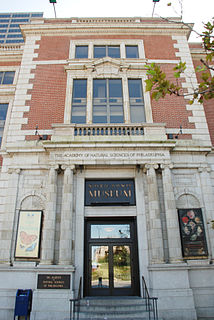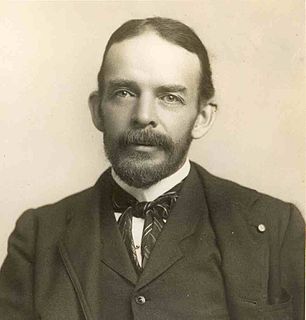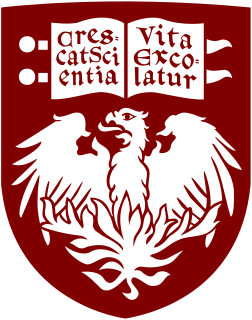
The Smithsonian Institution, also known simply as the Smithsonian, is a group of museums and research centers administered by the Government of the United States. It was founded on August 10, 1846 "for the increase and diffusion of knowledge". The institution is named after its founding donor, British scientist James Smithson. Originally organized as the "United States National Museum," that name ceased to exist as an administrative entity in 1967.

Spencer Fullerton Baird was an American naturalist, ornithologist, ichthyologist, herpetologist, and museum curator. Baird was the first curator to be named at the Smithsonian Institution. He would eventually serve as assistant Secretary of the Smithsonian from 1850 to 1878, and as Secretary from 1878 until 1887. He was dedicated to expanding the natural history collections of the Smithsonian which he increased from 6,000 specimens in 1850 to over 2 million by the time of his death. He published over 1,000 works during his lifetime.

The Academy of Natural Sciences of Drexel University, formerly the Academy of Natural Sciences of Philadelphia, is the oldest natural science research institution and museum in the Americas. It was founded in 1812, by many of the leading naturalists of the young American republic with an expressed mission of "the encouragement and cultivation of the sciences". For over two centuries of continuous operations, the Academy has sponsored expeditions, conducted original environmental and systematics research, and amassed natural history collections containing more than 17 million specimens. The Academy also has a long tradition of public exhibits and educational programs for both schools and the general public.

The National Museum of Natural History is a natural history museum administered by the Smithsonian Institution, located on the National Mall in Washington, D.C., United States. It has free admission and is open 364 days a year. In 2016, with 7.1 million visitors, it was the fourth most visited museum in the world and the most visited natural history museum in the world. Opened in 1910, the museum on the National Mall was one of the first Smithsonian buildings constructed exclusively to hold the national collections and research facilities. The main building has an overall area of 1,500,000 square feet (140,000 m2) with 325,000 square feet (30,200 m2) of exhibition and public space and houses over 1,000 employees.

George Brown Goode, was an American ichthyologist and museum administrator. He graduated from Wesleyan University and studied at Harvard University.

The Wagner Free Institute of Science is a natural history museum at 1700 West Montgomery Avenue in northern Philadelphia, Pennsylvania, USA. Founded in 1855, it is a rare surviving example of a Victorian era scientific society, with a museum, research center, library, and educational facilities. Its buildings, developed between 1859 and 1901, present the collections of founder William Wagner in the style of the period, and have been designated a National Historic Landmark for their architecture and state of preservation.
James Allen Hopson is an American paleontologist and professor at the University of Chicago. His work has focused on the evolution of the synapsids, and has been focused on the transition from basal synapsids to mammals, from the late Paleozoic through the Mesozoic Eras. He received his doctorate at Chicago in 1965, and worked at Yale before returning to Chicago in 1967 as a faculty member in Anatomy, and has also been a research associate at the Field Museum of Natural History since 1971. He has also worked on the paleobiology of dinosaurs, and his work, along with that of Peter Dodson, has become a foundation piece for the modern understanding of duckbill crests, social behavior, and variation.
Storrs Lovejoy Olson is an American biologist and ornithologist who spent his career at the Smithsonian Institution, retiring in 2008. One of the world's foremost avian paleontologists, he is best known for his studies of fossil and subfossil birds on islands such as Ascension, St. Helena and Hawaii. His early higher education took place at Florida State University in 1966, where he obtained a B.A. in Biology, and the University of Florida, where he received an M.S. in Biology. Olson's doctoral studies took place at Johns Hopkins University, in what was then the School of Hygiene and Public Health. He has been married to fellow paleornithologist Helen F. James.
The Caribbean Coral Reef Ecosystems (CCRE) program began with a collaborative field project conceived by six National Museum of Natural History scientists during the early 1970s. The scientists interests included a range of disciplines central to reef ecology, including: invertebrate and vertebrate zoology, botany, carbonate geology, and paleobiology. The primary work site is the Carrie Bow Marine Field Station, a research station at Carrie Bow Cay on the Meso-American Barrier Reef in Belize. The program is an extended duration study of coral reefs, mangroves, sea grass meadows, and the sandy bottoms. It has been a functioning research program since the early 1970s when it was called the Investigations of Marine Shallow-Water Ecosystems (IMSWE)
Xiaoming Wang is a noted vertebrate paleontologist and geologist born in People's Republic of China and now living and teaching in the United States.

Smithsonian Libraries (SIL), formerly known as Smithsonian Institution Libraries, is a library system comprising 20 branch libraries serving the various Smithsonian Institution museums and research centers, as well as central support services which include a Book Conservation Laboratory and an Imaging Center. The Libraries serve Smithsonian Institution staff as well as the scholarly community and general public with information and reference support. Its collections number over 1.5 million volumes including 40,000 rare books and 2,000 manuscripts. The Libraries also holds the United States' largest trade literature collection, which includes over 300,000 commercial catalogs dating from the early nineteenth century and representing more than 30,000 companies.
Alan H. Cheetham is a paleobiologist and retired senior scientist and curator of invertebrate paleontology at the Smithsonian Institution's National Museum of Natural History.
Donald Robert Whitehead (1938–1990) was an American entomologist, who specialized in the study of the biogeography and systematics of weevils.
Tyson Royal Roberts is an American ichthyologist. He has been described as "the world's foremost authority on Regalecus".

The Paleobiology Database is an online resource for information on the distribution and classification of fossil animals, plants, and microorganisms.
Aaron Goldberg was an American botanist and parasitologist. He died in December 2014 at the Holy Cross Hospital in Silver Spring, Maryland, at the age of 97.

Vicki Ann Funk is a Senior Research Botanist and Curator at the Smithsonian's National Museum of Natural History. She is known for her work on members of the composite family (Asteraceae) including collecting plants in many parts of the world, as well as her synthetic work on phylogenetics and biogeography.[1][2][3]
Alice R. Tangerini is an American botanical illustrator. In 1972, Tangerini was hired as a staff illustrator for the Department of Botany at the National Museum of Natural History by American botanist Lyman Bradford Smith. Prior to working at the Smithsonian Institution, she received a Bachelor of Fine Arts from Virginia Commonwealth University. As of March 9, 2017, Tangerini remains the only botanical illustrator ever hired by the Smithsonian.
Beryl Brintnall Simpson is a professor emeritus in the Department of Integrative Biology at the University of Texas at Austin. Previously she was an associate curator at the Smithsonian National Museum of Natural History in the Department of Botany. She studies tropical botany, focusing on angiosperms found in the American Southwest, Mexico, and Central and South America. She was awarded the José Cuatrecasas Medal for Excellence in Tropical Botany for her decades of work on the subject.
Walter John Emil Kress is an American botanist and the vice-president for science at the National Museum of Natural History. He currently holds the appointment (2010) as the Director of the new Consortium for Understanding and Sustaining a Biodiverse Planet at the Smithsonian and is the former Executive Director of the Association for Tropical Biology and Conservation.










